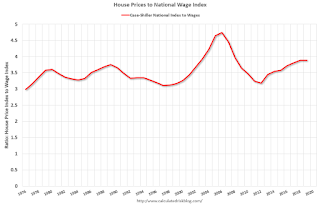One of the metrics we'd like to follow is a ratio of house prices to incomes. Unfortunately most income data is released with a significantly lag, and there are always questions about which income data to use (the average total income is skewed by the income of a few people).
And for key measures of house prices - like Case-Shiller - we have indexes, not actually prices.
But we can construct a ratio of the house price indexes to some measure of income.
For this graph I decided to look at house prices and the National Average Wage Index released today for 2018 from Social Security.
Note: For a different look at house prices and income, see this post (using median income).
 Click on graph for larger image.
Click on graph for larger image.
This graph shows the ratio of house price indexes divided by the National Average Wage Index (the Wage index is first divided by 1000).
This uses the annual average National Case-Shiller index since 1976.
As of 2018, house prices were somewhat above the median historical ratio - but far below the bubble peak.
Going forward, I think it would be a positive if wages outpaced, or at least kept pace with house prices increases for a few years.
Note: The national wage index for 2019 is estimated using the median increase over the last several years.
And for key measures of house prices - like Case-Shiller - we have indexes, not actually prices.
But we can construct a ratio of the house price indexes to some measure of income.
For this graph I decided to look at house prices and the National Average Wage Index released today for 2018 from Social Security.
Note: For a different look at house prices and income, see this post (using median income).
 Click on graph for larger image.
Click on graph for larger image.This graph shows the ratio of house price indexes divided by the National Average Wage Index (the Wage index is first divided by 1000).
This uses the annual average National Case-Shiller index since 1976.
As of 2018, house prices were somewhat above the median historical ratio - but far below the bubble peak.
Going forward, I think it would be a positive if wages outpaced, or at least kept pace with house prices increases for a few years.
Note: The national wage index for 2019 is estimated using the median increase over the last several years.